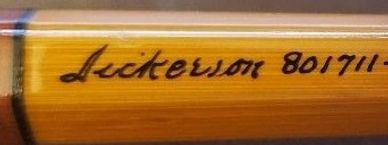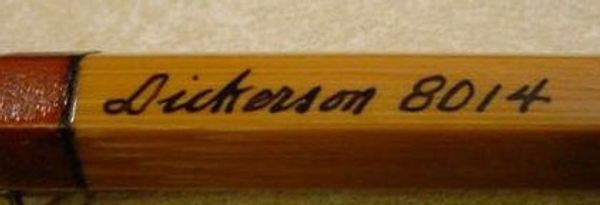Welcome to The Dickerson Site- Updated 10/13/2025, please see News & Updates section
Dickerson Rod Markings and Script
An overview on how Dickerson marked his rods, including how his markings and script evolved over his career.
Dickerson rods are always neatly signed and marked, which should be appreciated by collectors. He always signed a finished rod Dickerson and included the rod length/model at a minimum. A good percentage of Dickerson rods also have the year made and many have the person's name who the rod was made for. Very early rods were marked differently than his later system using rod length and ferrule sizes. Dickerson's first offerings were marked with the rod length and then a consecutive number; 1,2,3... A rod marked Dickerson 801 would be the first eight foot rod made and offered for sale, 802, the second. Dickerson 862, would be the second 8'6" rod made and so on. His records contain eight and eight foot six rods marked this way beginning in 1931. Dickerson did not use this marking system for long. After the consecutive rod numbering period, Dickerson marked rods in a straight forward manner such as, Dickerson 8 1/2' or "Dickerson-Detroit 8 1/2 ' , oftentimes followed by the year. In 1935, Dickerson began marking his rods with the model designation most commonly seen and continued to do so through the 1960s until the end of his career. The model designation is the rod length followed by the ferrule size(s) in 64th inches. A few examples:
- 7612 is a seven foot six inch two piece rod with a 12/64ths of an inch ferrule set
- 761510 is a seven foot six inch three piece rod with 15/64ths and 10/64ths inch ferrule sets
- 9016 is a nine foot two piece rod with a 16/64ths inch ferrule set
- 901812 is a nine foot three piece rod with 18/64ths and 12/64ths inch ferrule sets
Rods marked Dickerson- Bergman are not rods that were owned by Ray Bergman, they are rods that were ordered by and sold through Ray Bergman. The same goes for rods marked Dickerson-Leitz which were rods sold through Dick Leitz's sports shop in Michigan.
A few rare examples of script on rod tips has been seen. Dickerson generally reserved this practice for his very good customers who owned many Dickerson rods in order to avoid mixing up the tips of like rod models. The Sweeney family, who were perhaps Dickerson's best single customers, sometimes had their initials and rod model written on the tips below the ferrule wrap.
Many pre-war Dickerson rods have a "C", "D", or "E", designation immediately following the model number (861711D). The letter refers to the recommended line usage which was based on the diameter of a level line, C= .050" D=.045" E=.040". This system was used prior to the current AFMTA numbered line designations, which are based on line weight.
In evaluating Dickerson's rod script and how it changed throughout his career, it should be kept in mind that when he began making rods he was already approaching middle-age. Dickerson starting making rods in the early 1930s at about 40 years of age. The last rods made in his Bellaire shop were completed in 1972 at the age of 80. Though Dickerson always had very neat rod script, it did change over time. Considering the years spanned, it is easy to understand why these changes occurred.
Early on, in the 1930s, Dickerson's rod script was very neat, compact, and smaller in size; almost calligrapher-like in precision. As the years passed it evolved to be more open and slightly larger in size. This was generally the case through the 1950s. In the 1960’s his script was still neat, however, it did become noticeably larger, more open, and more plain in appearance.
Unfortunately, many Dickerson rods that have been restored have had the original script removed and rewritten. If you have an interest in collecting Dickerson rods, it is important to become very familiar with his writing. Study as much writing on original rods as possible, while being mindful in assuming that online examples are original, many are not.
Dickerson always signed his rods cursively. How he formed his letters is fairly consistent. One exception is the "s" in Dickerson. Occasionally Dickerson used a non-cursive "s" . This occurred most frequently in the 1930s but is also occasionally seen on later rods. An example of this alternative "s" can be seen below on the 1937 and 1947 rods shown.
Concentrate on how Dickerson formed and connected certain letters and how the script flows without any signs of stops. The characteristics of how he wrote numbers is also very worthy of study. Determine the era of the rod made and if possible, compare it to other examples of Dickerson rods from the same time period.
Dickerson always signed his rods with India ink. Often, non-original script on Dickerson rods is done with an engineer's or calligraphy pen. Some unoriginal script seen appears to have been done with a fine tipped felt marker. Dickerson's use of India ink produced a raised effect to his rod script. Due to the thin layer of varnish Dickerson generally used, the script can often be felt by running a finger over the varnish covering it.
The following examples appear in chronological order showing how Dickerson's script can differ. Also included are several examples of non-original script applied to Dickerson rods. Unfortunately, this is a more common occurrence on Dickerson rods than it should be due to the channels Dickerson rods have historically passed through for restoration.

Dickerson 8014 Guide presentation rod, 1951
Examples of Dickerson's signature & rod script with dates

1937

1939

1947

1948

1951

1955

1956

1957

1962

1964

1966
Marking rods with customer's name & year made

A rare example of Dickerson marking the rod tips with the owner's initials and model number, an 8014 made for John S. Sweeney Jr.

1937 rod made for Ned Jewett of Lapeer, MI, not far from Dickerson's Detroit shop

A rare 7012 made in 1951 for R.C. "Doc" Ammerman of Swarthmore, Pa.

1957 Dickerson 761510 made for good friend, Don Valley. This is the last three piece rod in Dickerson's records.

Fairly late rod made for Kenneth Cunningham in 1964

1948 Dickerson 8013 made for female angler, Signe Fellows

1962 Dickerson 7012 made for W.R. Paine

8014 Guide made in 1956 for Hal. E. Walker
Non-original Dickerson rod script

Non-original script on a Dickerson 901812 rod

Non-original script on a Dickerson 861610 rod

Non-original script on a Dickerson 661510 rod